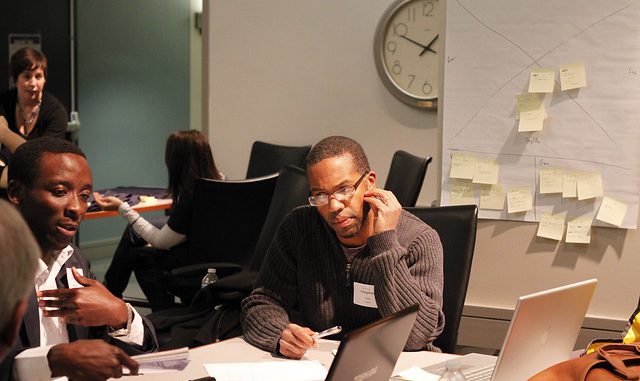
What is it?
Brainstorming is a method used to generate multiple answers or ideas. It encourages creativity and divergent thinking which can be used to solve problems or answer questions. It was popularised by Alex Osborn (1953), who worked in advertising in the 1950s, and has been widely used in the creative industries. You may have seen it in action on BBC TV’s ‘The Apprentice’ where teams often brainstorm ideas for products or product names. However it can be used more widely for educational purposes (it is a step in problem-based learning, for example).
Why do it?
It can serve a number of useful purposes:
- To review current knowledge: it can be helpful to start a session by recapping on the previous session or finding out what people know about the new topic. You could say: ‘Shout out anything you remember from last week.’ or ‘Tell me any words or phrases you associate with [the topic being covered].
- To generate multiple ideas that can lead to solving a problem. For example, if students expressed concern about how much they had to learn for an exam, you could have them brainstorm ideas on study techniques. Or, give them a scenario, (e.g. a patient with shortness of breath, a business that is losing money or a composer/artist/writer that’s run out of ideas), and have them brainstorm potential causes and/or solutions.
- To explore or map out different aspects of a topic. For example, you could have students brainstorm all the potential problems or issues that could arise when conducting a specified research method, factors to take into account when preparing a presentation, themes in a piece of literature, or factors that contributed to a historical event.
How do you set it up?
First, you need to think about the question. It should one for which there are a range of possible answers – this technique isn’t suitable if there are only one or two right answers.
Then you need to explain how it will work to the students. There are four key principles:
- More is better: quantity not quality is important at this stage.
- Encourage blue sky thinking (ie. thinking without limits): wild and wacky ideas are encouraged.
- No judgement: no one in the group should comment on the ideas as they are generated as this will inhibit people from contributing. Every idea is acceptable and should be recorded (there will be an opportunity to review them later).
- Participants can build on the ideas of others, so if someone has an idea that sparks a thought or elaboration in someone else, they can add it.
Having established the rules, you can start the brainstorm. Have the students call out their ideas whilst you record every idea, e.g. on a whiteboard or computer screen.
Ensure that students stick to the rules, for example, if anyone passes comment/sighs/groans when an idea is suggested, remind them of the ‘no judgement’ rule.
Once all the ideas have been collected, that is the end of the brainstorm. You can then decide whether you want to process the ideas, for example, grouping them into themes, prioritising them or having the students work in small groups to evaluate them. For example, going back to some previous scenarios:
- With the patient with shortness of breath, you could have students order the potential causes from most to least likely.
- With a business that is losing money, you could have students evaluate all the suggestions and choose one that they will work up into a proposal.
- With the factors that led to a historical event, you could classify them into economic, social, political etc.
Alternative ways to run brainstorms:
- Have the students brainstorm individually onto post-its (one idea per post-it) and then place them on a wall.
- Use technologies e.g. Google docs, Padlet, Polleverywhere, where students can add their ideas anonymously.
- Have students brainstorm in small groups and record their ideas on paper, which can then be passed round to other groups to discuss.
Considerations
When conducted as a verbal group exercise, the spontaneity of some students’ ideas may be blocked because others are talking. The larger the group, the more of a problem this can be. Some students may feel anxious and be unwilling to contribute to large group brainstorms. These issues may be resolved using manually or electronically written ideas as these are more anonymous and everyone can submit simultaneously. Electronic submission also allows the same purposes to be achieved remotely and over a longer time period.
The effectiveness of brainstorming in generating high quality solutions has been disputed with some studies showing that better results are achieved with people working individually or debating ideas as they arise (Goldenberg and Wiley, 2011).
Examples and resources
Videos
- From Sprouts, a short video introduction (5 min 31 sec).
- How not to brainstorm – a demonstration from Stanford D.School students (followed by how to do it effectively).
- Example of brainstorming for a business problem in two stages: post-its, then sharing.
Articles
- Example of brainstorming in language teaching – Rao, Z. (2007). Training in brainstorming and developing writing skills. ELT Journal, 61(2), 100–106. https://doi.org/10.1093/elt/ccm002.
- Example in anatomy teaching: Geuna, S., & Giacobini-Robecchi, M. G. (2002). The use of brainstorming for teaching human anatomy. The Anatomical Record, 269(5), 214–216. https://doi.org/10.1002/ar.10168.
References
- Osborn, A.F., 1953. Applied Imagination: Principles and Procedures of Creative Problem Solving New York: Charles Scribner’s Sons.
- Goldenberg O, Wiley J., 2011. Quality, Conformity, and Conflict: Questioning the Assumptions of Osborn’s Brainstorming Technique. The Journal of Problem Solving;3(2).
Guide contributed by Mary Seabrook, King’s Academy.
Image source: sarah e. binder, 2012. Brainstorming. https://www.flickr.com/photos/88158446@N02/8060743284. Licensed as CC BY-NC 2.0.

Leave a Reply